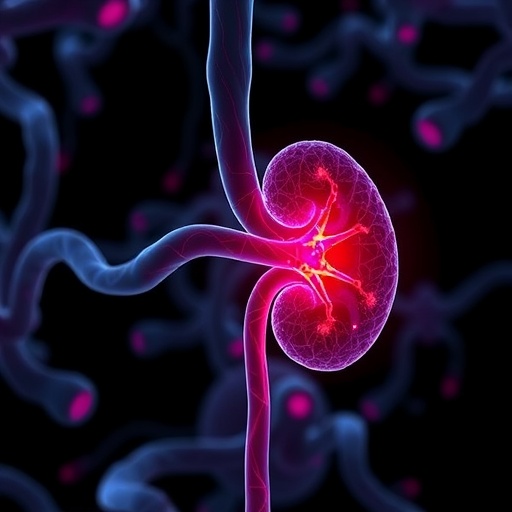In the rapidly evolving landscape of cancer diagnostics, researchers have taken a significant leap forward by harnessing the power of machine learning to predict molecular biomarkers non-invasively. A groundbreaking study published in BMC Cancer unveils an innovative radiogenomic approach that combines advanced imaging techniques with machine learning algorithms to predict the expression of microRNA-15a (miR-15a) in renal cell carcinoma (RCC). This achievement promises to enhance precision medicine strategies and improve patient outcomes in one of the most prevalent and deadly kidney cancers.
Renal cell carcinoma represents a diverse group of kidney tumors characterized by a wide range of clinical behaviors, from indolent forms to highly aggressive variants. Traditional diagnostic and prognostic tools have often fallen short in accurately stratifying patients, largely due to the tumor’s heterogeneity. The study in question bridges this gap by integrating radiological imaging features with molecular data, specifically focusing on miR-15a, a microRNA implicated in regulating essential cancer processes such as angiogenesis, apoptosis, and cellular proliferation.
MicroRNAs have emerged as crucial players in cancer biology, influencing gene expression patterns that dictate tumor behavior. MiR-15a, in particular, has garnered attention as a potential biomarker due to its documented association with tumor aggressiveness and therapeutic responsiveness in RCC. However, quantifying its expression traditionally requires invasive tissue sampling, which is not always feasible or safe. This study’s radiogenomic model offers a non-invasive alternative, enabling clinicians to infer molecular characteristics directly from imaging data.
.adsslot_QPLa8yMUtz{width:728px !important;height:90px !important;}
@media(max-width:1199px){ .adsslot_QPLa8yMUtz{width:468px !important;height:60px !important;}
}
@media(max-width:767px){ .adsslot_QPLa8yMUtz{width:320px !important;height:50px !important;}
}
ADVERTISEMENT
The research team retrospectively analyzed data from 64 RCC patients who underwent preoperative multiphase contrast-enhanced computed tomography (CT) or magnetic resonance imaging (MRI). Using these images, they extracted radiological features including tumor size, presence of necrosis, nodular enhancement patterns, cystic components, and the occurrence of macroscopic fat within tumors. These parameters are known to reflect underlying tumor biology, but their precise relationship with molecular markers like miR-15a had not been rigorously quantified until now.
To establish a predictive framework, the researchers quantified miR-15a expression through real-time quantitative polymerase chain reaction (qPCR) analysis of archived tumor tissues, creating a robust molecular ground truth. They then applied sophisticated machine learning models—namely polynomial regression and Random Forest algorithms—to map the complex relationships between radiological features and miR-15a levels. The choice of Random Forest models, known for handling nonlinear data and interactions among variables, was critical in capturing the intricate dynamics between imaging and molecular expression.
The results were striking. Among all radiological predictors, tumor size emerged as the strongest correlate of miR-15a expression, explaining over 82% of the variance in expression levels with high statistical significance. Importantly, elevated miR-15a levels were linked with aggressive imaging features such as tumor necrosis and nodular enhancement, both markers of malignancy. Conversely, lower miR-15a expression was associated with less aggressive features like cystic changes and intratumoral fat, highlighting the model’s ability to discern phenotypic variations accurately.
The Random Forest regression model explained approximately 66% of the variance in miR-15a expression, demonstrating solid performance in complex biological prediction. Even more impressively, the classification model achieved perfect discrimination between high and low miR-15a expression categories, boasting an area under the curve (AUC) of 1.0, precision of 1.0, recall of 0.9, and an F1-score of 0.95. These metrics underscore the remarkable potential of machine learning to revolutionize biomarker prediction directly from imaging data.
Beyond prediction, the study employed hierarchical clustering combined with K-means analysis to stratify tumors into distinct phenotypic groups. This stratification coincided with clinical aggressiveness, effectively segregating tumors into aggressive and indolent categories. Such phenotypic mapping not only enhances diagnostic precision but also paves the way for tailored therapeutic interventions, aligning perfectly with the goals of personalized oncology.
The implications of this study extend well beyond RCC. By demonstrating the feasibility and accuracy of machine learning-assisted radiogenomics, the researchers illuminate a path toward non-invasive molecular profiling that could be applied across diverse cancer types. The integration of radiological imaging with molecular data allows clinicians to visualize tumor biology in real time, guiding treatment decisions without necessitating invasive biopsies that carry risks and discomfort for patients.
This radiogenomic approach also accelerates the timeline from diagnosis to treatment by providing rapid, reproducible assessments of tumor behavior. The ability to predict miR-15a expression non-invasively could inform prognosis, predict responsiveness to targeted therapies, and monitor disease progression or recurrence, thereby improving overall patient management and survival prospects.
Moreover, the study underscores the growing role of artificial intelligence and machine learning in modern medicine. By handling large, multidimensional datasets and uncovering hidden patterns, these technologies enable insights that transcend traditional statistical approaches. The Random Forest algorithm’s capacity to model complex interactions between imaging features and molecular expression exemplifies how AI can unlock new dimensions of understanding in oncological research.
While the sample size of 64 patients provides a solid proof of concept, future studies with larger and more diverse cohorts will be essential to validate and generalize these findings. Additionally, expanding this radiogenomic framework to incorporate other microRNAs, gene expression profiles, and proteomic data could further enhance tumor characterization and therapeutic precision.
It is also important to acknowledge the technical challenges and limitations. Imaging protocols and machine learning models require standardization across institutions to ensure reproducibility and clinical applicability. Furthermore, interpretability of AI models remains a key concern, mandating transparent frameworks that clinicians can trust and integrate into routine workflows.
Despite these considerations, this study marks a pivotal advancement in cancer diagnostics. It highlights how the convergence of imaging science, molecular biology, and computational intelligence can generate powerful tools for early detection, risk stratification, and individualized treatment planning in RCC. This synergy epitomizes the transformative potential of precision oncology in the 21st century.
As the medical community continues to grapple with the complexities of cancer heterogeneity, such radiogenomic models may soon become indispensable assets. They offer the promise of less invasive, cost-effective, and highly accurate diagnostics that enrich clinical decision-making, ultimately translating into better patient care and improved outcomes.
The integration of miR-15a expression prediction through machine learning-assisted radiogenomics heralds a new era in RCC management. By bridging the gap between tumor imaging and molecular pathology, this approach empowers clinicians with precise, actionable information that was previously accessible only through invasive procedures. As such, it sets the stage for further innovations and broader adoption of technology-driven personalized medicine in oncology.
In conclusion, the study’s innovative methodology and robust results emphasize the potential for machine learning to unlock the hidden molecular landscape of tumors from routine imaging scans. The prospect of accurately predicting critical biomarkers like miR-15a non-invasively not only enhances our understanding of RCC biology but also catalyzes the evolution of smarter, more effective cancer care.
Subject of Research: Prediction of microRNA-15a expression in renal cell carcinoma using machine learning-assisted radiogenomic analysis.
Article Title: Machine learning-assisted radiogenomic analysis for miR-15a expression prediction in renal cell carcinoma
Article References:
Mytsyk, Y., Kowal, P., Kobilnyk, Y. et al. Machine learning-assisted radiogenomic analysis for miR-15a expression prediction in renal cell carcinoma. BMC Cancer 25, 1349 (2025). https://doi.org/10.1186/s12885-025-13963-x
Image Credits: Scienmag.com
DOI: https://doi.org/10.1186/s12885-025-13963-x
Tags: AI in cancer diagnosticsimaging techniques in cancer diagnosisimproving patient outcomes in kidney cancermachine learning in renal cell carcinomamicroRNA influence on cancer biologymiR-15a as a biomarkermolecular biomarkers in oncologynon-invasive cancer predictionprecision medicine strategiespredictive analytics in healthcareradiogenomics in kidney cancertumor heterogeneity in RCC





